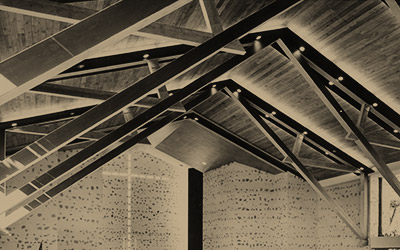Alfred Preis
The USS Arizona Memorial (1959-1962)Its gleaming white countenance shimmering across the waters of Pearl Harbor, the USS Arizona Memorial of the Pacific seems to float on Pearl Harbor’s rippling waters without visible means of support. The gracefully simple catenary curve of its body reinforces an ethereal impression, while employing a variation of one of the architect’s favored silhouettes, the butterfly roof.
Resting on 150-foot-deep concrete piles, the concrete memorial straddles the sunken hull of the battleship USS Arizona. Splendidly open to Hawaii’s soothing trade winds and azure sea and sky, seven, elongated hexagons open each side to bow-to-stern views of the submerged ship and surrounding seascape, while no ceiling impedes the warmth of the sun. A trapezoidal opening in the memorial’s terrazzo deck provides an up close and personal view down at the rusting hulk, a mere eight feet below, sitting in its watery grave and still leaking oil.
Design details such as the unsupported corners of the opening’s stainless-steel handrail, may rarely be consciously noted by the visitors, yet add to the subtle grace of their experience. Similarly, as with much of Preis’s buildings, right angles are shunned, further transposing the memorial from the everyday world into one conducive to serene contemplation.
Following a processional sequence, visitors move from an enclosed vestibule to a visceral encounter with the languishing remains of the battleship to ultimately arrive within the confines of the hallowed far end of the memorial with its ever-so-slightly concave marble wall bearing the names of the 1,177 men who perished on board the ship and remain entombed below. The fragmented, jagged apertures of the room throw shadows upon the moment, while expressing the violent destruction of the battle. As a monument to the tragedy of war, the Arizona Memorial eloquently communicates its solemn message, its design successfully addresses and augments the emotions elicited by the physical presence of that “day that will live in infamy.”












